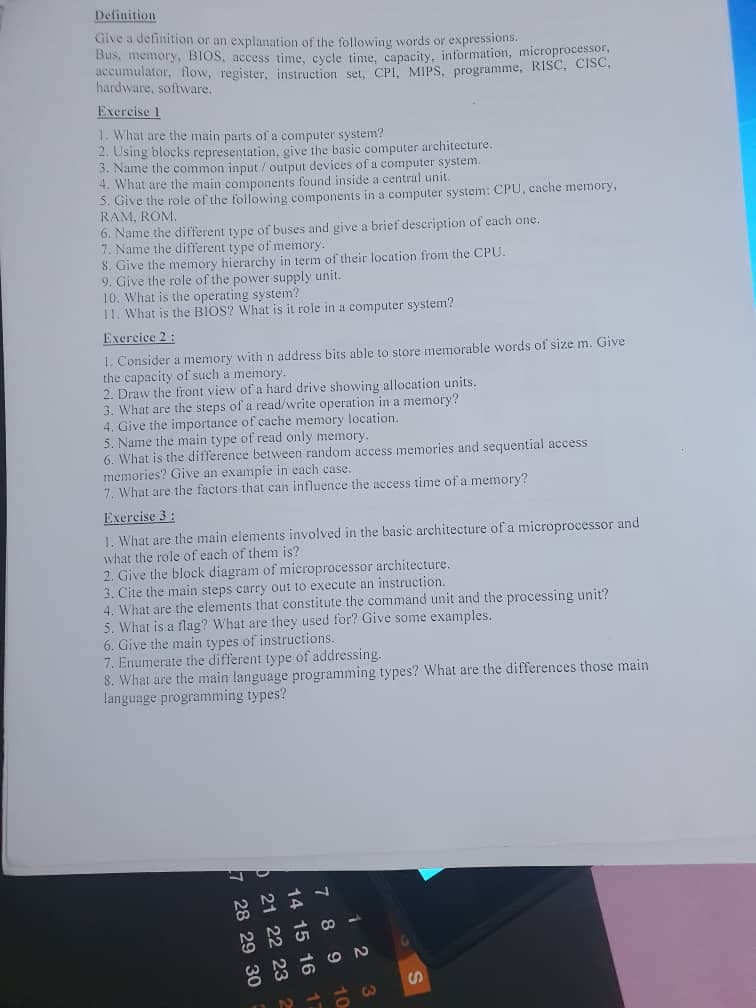Please exercise 1
Computer Networking: A Top-Down Approach (7th Edition)
7th Edition
ISBN:9780133594140
Author:James Kurose, Keith Ross
Publisher:James Kurose, Keith Ross
Chapter1: Computer Networks And The Internet
Section: Chapter Questions
Problem R1RQ: What is the difference between a host and an end system? List several different types of end...
Related questions
Question
Please exercise 1

Transcribed Image Text:Definition
Give a definition or an explanation of the following words or expressions.
Bus, memory, BIOS, access time, cycle time, capacity, information, microprocessor,
accumulator, flow, register, instruction set, CPI, MIPS, programme, RISC, CISC,
hardware, software.
Exercise 1
1. What are the main parts of a computer system?
2. Using blocks representation, give the basic computer architecture.
3. Name the common input/output devices of a computer system.
4. What are the main components found inside a central unit.
5. Give the role of the following components in a computer system: CPU, cache memory,
RAM, ROM.
6. Name the different type of buses and give a brief description of each one.
7. Name the different type of memory.
8. Give the memory hierarchy in term of their location from the CPU.
9. Give the role of the power supply unit..
10. What is the operating system?
11. What is the BIOS? What is it role in a computer system?
Exercice 2:
1. Consider a memory with n address bits able to store memorable words of size m. Give
the capacity of such a memory.
2. Draw the front view of a hard drive showing allocation units.
3. What are the steps of a read/write operation in a memory?
4. Give the importance of cache memory location.
5. Name the main type of read only memory.
6. What is the difference between random access memories and sequential access
memories? Give an example in each case.
7. What are the factors that can influence the access time of a memory?
Exercise 3:
1. What are the main elements involved in the basic architecture of a microprocessor and
what the role of each of them is?
2. Give the block diagram of microprocessor architecture.
3. Cite the main steps carry out to execute an instruction.
4. What are the elements that constitute the command unit and the processing unit?
5. What is a flag? What are they used for? Give some examples.
6. Give the main types of instructions.
7. Enumerate the different type of addressing.
8. What are the main language programming types? What are the differences those main
language programming types?
7 28 29 30
21 22 23 2
14 15 16 17
7 8 9
12
10
3
S
Expert Solution
This question has been solved!
Explore an expertly crafted, step-by-step solution for a thorough understanding of key concepts.
Step by step
Solved in 5 steps with 1 images

Recommended textbooks for you

Computer Networking: A Top-Down Approach (7th Edi…
Computer Engineering
ISBN:
9780133594140
Author:
James Kurose, Keith Ross
Publisher:
PEARSON

Computer Organization and Design MIPS Edition, Fi…
Computer Engineering
ISBN:
9780124077263
Author:
David A. Patterson, John L. Hennessy
Publisher:
Elsevier Science

Network+ Guide to Networks (MindTap Course List)
Computer Engineering
ISBN:
9781337569330
Author:
Jill West, Tamara Dean, Jean Andrews
Publisher:
Cengage Learning

Computer Networking: A Top-Down Approach (7th Edi…
Computer Engineering
ISBN:
9780133594140
Author:
James Kurose, Keith Ross
Publisher:
PEARSON

Computer Organization and Design MIPS Edition, Fi…
Computer Engineering
ISBN:
9780124077263
Author:
David A. Patterson, John L. Hennessy
Publisher:
Elsevier Science

Network+ Guide to Networks (MindTap Course List)
Computer Engineering
ISBN:
9781337569330
Author:
Jill West, Tamara Dean, Jean Andrews
Publisher:
Cengage Learning

Concepts of Database Management
Computer Engineering
ISBN:
9781337093422
Author:
Joy L. Starks, Philip J. Pratt, Mary Z. Last
Publisher:
Cengage Learning

Prelude to Programming
Computer Engineering
ISBN:
9780133750423
Author:
VENIT, Stewart
Publisher:
Pearson Education

Sc Business Data Communications and Networking, T…
Computer Engineering
ISBN:
9781119368830
Author:
FITZGERALD
Publisher:
WILEY